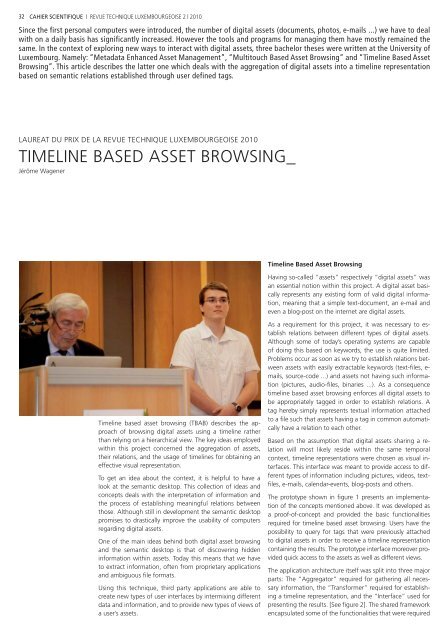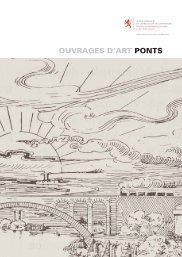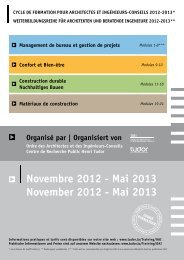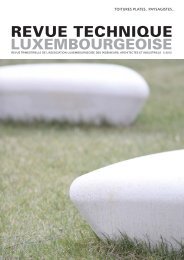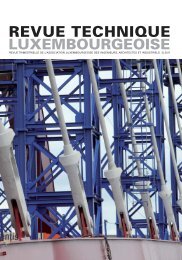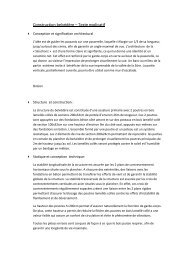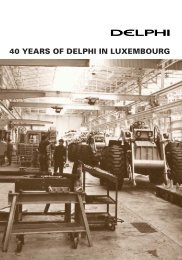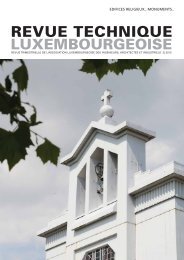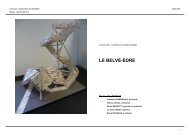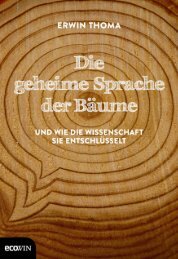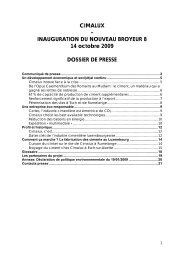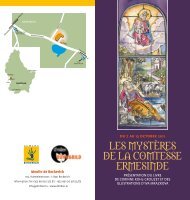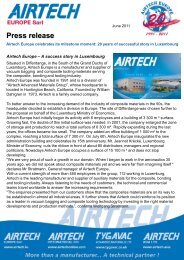cahier scientifique revue technique luxembourgeoise
cahier scientifique revue technique luxembourgeoise
cahier scientifique revue technique luxembourgeoise
Erfolgreiche ePaper selbst erstellen
Machen Sie aus Ihren PDF Publikationen ein blätterbares Flipbook mit unserer einzigartigen Google optimierten e-Paper Software.
32 CAHIER SCIENTIFIQUE | REVUE TECHNIQUE LUXEMBOURGEOISE 2 | 2010<br />
Since the first personal computers were introduced, the number of digital assets (documents, photos, e-mails ...) we have to deal<br />
with on a daily basis has significantly increased. However the tools and programs for managing them have mostly remained the<br />
same. In the context of exploring new ways to interact with digital assets, three bachelor theses were written at the University of<br />
Luxembourg. Namely: “Metadata Enhanced Asset Management”, “Multitouch Based Asset Browsing” and “Timeline Based Asset<br />
Browsing”. This article describes the latter one which deals with the aggregation of digital assets into a timeline representation<br />
based on semantic relations established through user defined tags.<br />
LAUREAT DU PRIX DE LA REVUE TECHNIQUE LUXEMBOURGEOISE 2010<br />
TIMELINE BASED ASSET BROWSING_<br />
Jérôme Wagener<br />
Timeline based asset browsing (TBAB) describes the approach<br />
of browsing digital assets using a timeline rather<br />
than relying on a hierarchical view. The key ideas employed<br />
within this project concerned the aggregation of assets,<br />
their relations, and the usage of timelines for obtaining an<br />
effective visual representation.<br />
To get an idea about the context, it is helpful to have a<br />
look at the semantic desktop. This collection of ideas and<br />
concepts deals with the interpretation of information and<br />
the process of establishing meaningful relations between<br />
those. Although still in development the semantic desktop<br />
promises to drastically improve the usability of computers<br />
regarding digital assets.<br />
One of the main ideas behind both digital asset browsing<br />
and the semantic desktop is that of discovering hidden<br />
information within assets. Today this means that we have<br />
to extract information, often from proprietary applications<br />
and ambiguous fi le formats.<br />
Using this <strong>technique</strong>, third party applications are able to<br />
create new types of user interfaces by intermixing different<br />
data and information, and to provide new types of views of<br />
a user’s assets.<br />
Timeline Based Asset Browsing<br />
Having so-called “assets” respectively “digital assets” was<br />
an essential notion within this project. A digital asset basically<br />
represents any existing form of valid digital information,<br />
meaning that a simple text-document, an e-mail and<br />
even a blog-post on the internet are digital assets.<br />
As a requirement for this project, it was necessary to establish<br />
relations between different types of digital assets.<br />
Although some of today’s operating systems are capable<br />
of doing this based on keywords, the use is quite limited.<br />
Problems occur as soon as we try to establish relations between<br />
assets with easily extractable keywords (text-fi les, emails,<br />
source-code ...) and assets not having such information<br />
(pictures, audio-fi les, binaries ...). As a consequence<br />
timeline based asset browsing enforces all digital assets to<br />
be appropriately tagged in order to establish relations. A<br />
tag hereby simply represents textual information attached<br />
to a fi le such that assets having a tag in common automatically<br />
have a relation to each other.<br />
Based on the assumption that digital assets sharing a relation<br />
will most likely reside within the same temporal<br />
context, timeline representations were chosen as visual interfaces.<br />
This interface was meant to provide access to different<br />
types of information including pictures, videos, textfi<br />
les, e-mails, calendar-events, blog-posts and others.<br />
The prototype shown in fi gure 1 presents an implementation<br />
of the concepts mentioned above. It was developed as<br />
a proof-of-concept and provided the basic functionalities<br />
required for timeline based asset browsing. Users have the<br />
possibility to query for tags that were previously attached<br />
to digital assets in order to receive a timeline representation<br />
containing the results. The prototype interface moreover provided<br />
quick access to the assets as well as different views.<br />
The application architecture itself was split into three major<br />
parts: The “Aggregator” required for gathering all necessary<br />
information, the “Transformer” required for establishing<br />
a timeline representation, and the “Interface” used for<br />
presenting the results. [See fi gure 2]. The shared framework<br />
encapsulated some of the functionalities that were required


